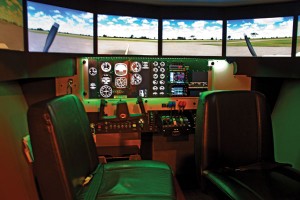Flight Safety – by Michael Kaufman
Certified Flight Instructor – Instrument
 Many of you are familiar with the safety programs that the Federal Aviation Administration (FAA) has been conducting around the country, and you may have noticed changes in the programs over the last several years. The FAA has now given the duties of conducting the programs to volunteers that have received appointments to the FAA Safety Team (FAAst). I have been working as a member of this team since its inception several years ago.
Many of you are familiar with the safety programs that the Federal Aviation Administration (FAA) has been conducting around the country, and you may have noticed changes in the programs over the last several years. The FAA has now given the duties of conducting the programs to volunteers that have received appointments to the FAA Safety Team (FAAst). I have been working as a member of this team since its inception several years ago.
On April 17, 2010, the FAA Safety Team gave a presentation in Tomahawk, Wisconsin with a slightly different tone than previous programs. Where all of the programs are designed to be informative and emphasize safety, geared toward all pilots, this program was tailored to pilots who fly aircraft as part of their work.
April 17th turned out to be a day when the weatherman challenged all pilots to make crosswind landings beyond the capability of most aircraft that I have flown on Tomahawk’s single runway, Runway 9/27. The wind was 90 degrees crossed to the runway and exceeded 35 knots. Several of the demo aircraft from Cirrus and Beechcraft were unable to land at Tomahawk, along with numerous attendees.
Jeff Taylor of the Wisconsin Department of Transportation, Bureau of Aeronautics, and an FAA safety team member, brought the group up to speed on aviation weather in Wisconsin. Harold Green of Morey Airplane Company, Middleton, Wis., presented an excellent approach to aeronautical decision-making. I presented a review on instrument flying with a look into the future with the coming of Automatic Dependent Surveillance-Broadcast (ADS-B) technology.
Many of you may ask why we chose Tomahawk for this presentation, which is the highlight of this article. Tomahawk is the location of a new “Redbird” flight simulator, and the only one in Wisconsin that I am aware of. The Redbird simulator is one of the newest and best light aircraft simulators that I have flown to date. Besides having an excellent graphic display, it is full-motion based.
The introduction of motion into flight simulators is not new, and it has been used to train airline and professional pilot crews for many years. I have flown the Cessna 421, Gulfstream III, Lockheed 1011, and Boeing 737 flight simulators during my flying career and have been awed by the realism of motion-based simulators. Until Redbird introduced its motion-based light aircraft simulator, the cost of motion-based simulators was left to professional crews.
Previous professional simulators cost millions of dollars, and in many cases, exceeded the cost of the aircraft they simulated. These high-dollar simulators were on hydraulic jacks that provided the motion; Redbird uses electric motors to provide the motion for their simulator.
If you were to take simulator training from Flight Safety or Simuflight, the cost is nearly $10,000 and includes ground school and about 20 hours of simulator time. Because it is best to train with the avionics equipment that is in the aircraft you are flying, the simulators have modules that they change in the simulator to closely represent the exact aircraft you are flying. Redbird has the same concept. At the time of this article, the Tomahawk Redbird can simulate a Cessna 182RG with conventional “steam gauges,” a Cessna 182 fixed gear with a G1000 Glass Panel, or a Beechcraft Baron 58 with “steam gauges.”
I had the chance to fly the Cessna 182RG on a demo flight with Bob Lussow, and I need to comment on the close realism to the aircraft I was flying.
When I flew my first motion-based simulator, my instructor explained that altering a simulator session to a situation that cannot be done in the aircraft, could cause a student to become uncomfortable or experience nausea. Some examples would be stopping a flight or backing the simulator up to correct a pilot error.
Simulators have two very important concepts in the flight training environment: 1) To save money and fuel in the cost of training, and 2) To practice maneuvers that cannot be done without some risk in the aircraft.
I remember crashing the simulator on my first simulator course many years ago. The instructor loaded me up with so many emergencies at one time that I lost the aircraft. After a simulator crash, a technician needs to be called in to reset the jacks. I learned later from the instructor that every pilot in the initial program gets to experience a crash.
High-end simulators have played an important part in aircraft training. In some instances, pilots may receive type ratings in FAA-approved simulators without ever having flown the actual aircraft. There is a list of FAA requirements that can be accomplished in the Redbird simulator, which is available from Redbird and Bob Lussow in Tomahawk.
If you are in need of some initial or recurrent training, consider looking into the simulator training program in Tomahawk.
EDITOR’S NOTE: Michael “Mick” Kaufman is the program manager for the Beechcraft Pilot Proficiency Program and a flight instructor operating out of Lone Rock (LNR) and Eagle River (EGV), Wisconsin. Kaufman was named “FAA’s Safety Team Representative of the Year for Wisconsin” in 2008.